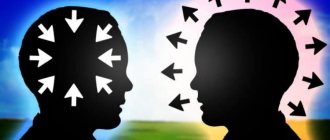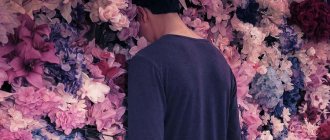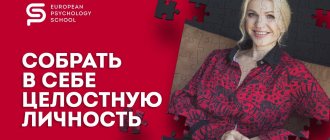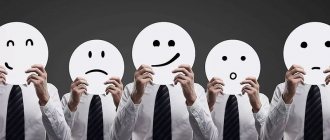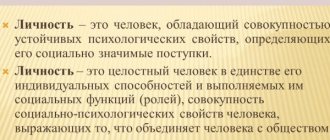Embracing an archetype
Excessive identification of consciousness with an archetypal image speaks of “being captured by the archetype.” Sometimes, it really looks like an obsession, when it seems that some foreign essence has taken possession of a person’s psyche and controls him. In fact, this seems to be true. While engulfed by an archetype, the individual loses conscious control, and power over his behavior is in the hands of the unconscious, instinctive.
At the same time, the archetypes themselves are objective, and the true causes of phenomena lie in the symbolism of archetypal plots. This mechanism explains why some dreams can be warning or prophetic in nature.
A mother in the form of a witch or a father with the head and hooves of a goat - such scenes in a dream can be interpreted as a warning about distortions in the sleeper’s perception of reality. The subconscious has more complete information about reality. And every now and then, it tries to reach consciousness in a dream, sending it signs designed to protect it from forming false beliefs in reality. Such dreams are often experienced by people whose relationships with their parents have taken an artificial form of goodwill, for example, as a result of being raised according to the model of overprotection - suffocating care. Such clients at an appointment with a psychologist are surprised why their beloved mother appears in their dreams in the form of an evil witch. However, this is a clear sign of repressing certain thoughts and feelings of a person regarding the mother, in this case, to the subconscious level.
Which of the 12 archetypes do you belong to – A Real Me
The test will take you 10–15 minutes, you need to answer 12 questions. The number of responses to each statement varies. It’s interesting that all the questions revolve around one topic – flying on an airplane. But they relate to different human reactions and behavior in a specific situation. For example, where you will sit on the plane or what you will do after takeoff.
In such a critical situation, especially if a person is terribly afraid of flying, all real, sincere emotions are visible, which determines the model of behavior. An entertaining questionnaire.
What I especially liked about the test was the design: it’s immediately clear who you really are. I saw that I was a “Hero”. Even the picture is so militant! Then the life goal is succinctly and clearly described, and then talent and greatest fear. It was interesting to read... After this, a description of the main characteristics of the type, qualities, habits, and behavior is given.
The results are presented according to a clear structure, everything is clear, and no unnecessary questions arise. So feel free to take the survey. And don’t forget to write in the comments which of the proposed tests you liked the most!
Take the test→
Power over archetypes
Awareness of the system of one's own archetypes gives a person power over them. In the ability to recognize and decipher archetypes, a connection is made between two previously separated spheres of the human soul: consciousness and the unconscious. This connection in Jung's theory is reflected in the archetype of wholeness or “Self”.
Interpretation and analysis of your own archetypal dreams and ideas is the path to personal development and spiritual growth.
Understanding the language of the subconscious gives access to the true causes of phenomena and life situations encrypted in archetypes. Awareness is an opportunity for a person to gain free choice. Only through awareness of the influence of archetypes is it possible to manifest individuality, which is not mediated by unconscious irrational motives. From Jung's point of view, individuality is the antipode of archetypicality. By demonstrating his individuality in a conscious choice, a person moves away from given patterns of behavior. In this way he expresses his creative essence. Individuation is the path of soul evolution. This is the path from being captured by archetypes to achieving integrity, when consciousness and the unconscious merge into a single core of personality.
Mandala is a symbol of the archetype of the Self.
Jung's Basic Archetypes
In the personality structure, Jung identified 3 areas:
- consciousness;
- personal unconscious;
- collective unconscious.
Consciousness is the “I am aware” here and now. The personal unconscious is something that was previously conscious, but has moved to the level of the unconscious. But the collective unconscious is not acquired during life, but is inherited, like an information package of images and forms. At the same time, personality development according to Jung is based on the interaction of 5 main archetypes, with the help of which the connection between consciousness and the unconscious is carried out.
Jung's main archetypes:
- Ego;
- Anima and Animus;
- Shadow;
- A person;
- Self.
The dark aspect of Anima or the Shadow archetype in the form of Maleficent.
Influence
Archetypes are still studied and used in various fields of science and human life. Archetypal pedagogy emerged. This is a direction that helps a teacher grow in the spiritual and psychological sphere.
In 2001, a book was published that described archetypes in brand marketing. It is called "Hero and Rebel". One of the authors was Carol Pearson (creator of the archetype questionnaire). The main idea of the book was that the winner is the brand that uses established images in its advertising that bring them closer to archetypes.
A psychological test will help determine the archetype. It contains simple questions that must be answered completely honestly. This will help determine the potential, capabilities, strengths and weaknesses of the individual.
Ego or "I"
The ego is the center of the psychic sphere. Here is the point of observation of the conscious “I” over the internal and external worlds. This is where the path of personality development or “individualization” begins, as Carl Gustav Jung defined it.
Individualization is the merging of consciousness and the unconscious in one single structure - the archetypal image of the Self .
Anima in the image of Eurydice, rescued from the underworld by Orpheus.
Anima and Animus
Anima and Animus in Jung's analytical psychology denote the image of the opposite sex in genetic memory. Anima is the feminine in a man. Animus is the masculine in a woman. Jung calls this the image of the soul. It is in this image that people choose each other to build relationships and create a family. The image of the soul carries within itself the experience of all humanity, the experience of the race and the personal experience of a person in the sphere of relationships.
Anima and animus can take on a variety of archetypal forms, illuminating a positive or negative aspect of the personality.
For example, the feminine principle can be manifested in the role of a gentle maiden or an evil witch . The masculine principle can appear before consciousness in the form of a noble prince or a jealous tyrant.
The image of the soul influences not only the choice of a partner, but also relationships with the opposite sex in general. Who am I for my husband or wife - a “noble lady of the heart” or a “jealous vixen”; "knight" or "bluebeard"? Also, the manifestation of gender qualities in a person’s character, for the most part, depends on the individual archetype of Anima/Animus in the human psyche.
Anima archetype in the image of Venus - the goddess of beauty.
The Anima and Animus archetypes are dual, but their duality is in equilibrium.
The power of manifestation of one aspect gives strength for the manifestation of the opposite. For example, external demonstrations of strength indicate internal weakness. A strong woman who performs male tasks in life carries in her consciousness the image of a weak animus, according to which she subconsciously searches for an appropriate life partner. That's why women who are too strong choose men who are too weak. In general, we always choose those whose qualities reflect our inner nature.
Negative aspect of the Hero
In fact, like other archetypes, the Hero can manifest his full negative potential if the circumstances are right. In the worst cases, he becomes power-hungry, tough and even cruel, incredibly arrogant, suffering from paranoia - an eternal search for enemies. The hero can be considered the same Genghis Khan, who sought to conquer the world and did it by at least a third. However, his path was filled with destruction, looting and violence. The Hero archetype can be divided into several levels, and at the lowest of them the only thing he wants is power, as much power as possible. Therefore, there is a certain trap in the Hero. A person may perceive himself as a noble savior of the world from evil, but the people around him will rightly see him as a villain who actually destroys and does not save.
Thus, the worst thing for any Hero is to one day find himself in the role of a tyrant, a tyrant, feared by everyone around him who previously idolized him. This is not his only fear - for the Hero it is also scary to understand that he is not strong and courageous enough to complete the task assigned to him, to fall under the negative influence of others and turn out to be a tool for fulfilling other people’s evil goals, to become excessively cruel and demanding towards the weak, whom needs to be protected.
But since most often the deep motives of all the Hero’s actions are two ideas - the idea of superpower or the idea of justice, the risk of slipping into the negative is sometimes very high, since the ideas themselves seem incredibly high and essentially unattainable.
Shadow Archetype
The shadow is formed from attitudes and inclinations that were inherited to us, but which we ourselves do not accept. Everything that seems unflattering and unaesthetic; everything that we are accustomed to hiding from society behind masks of decency forms the Shadow archetype.
Jung concluded: what was rejected at the level of consciousness goes into the realm of the unconscious. And from there, through the Shadow archetype, it continues its impact on the psyche and behavior. The more actively repression works, the larger the Shadow becomes, and the more often and more strongly it interferes with conscious life.
The Shadow archetype in the image of Mephistopheles (left) from Goethe's novel Faust.
However, although the Shadow represents the dark aspect of the personality, its goals are quite constructive.
With its intervention in conscious life, the Shadow directs the personality towards the satisfaction of his repressed desires and the release of unexpressed emotions. Ultimately, the intervention of the Shadow should lead the individual to awareness and acceptance of his shadow side. Otherwise, what Jung called “the flooding of consciousness with archetypal unconscious content” occurs. In other words, psychosis.
The shadow reminds of itself both through the symbolism of the inner world (dreams) and in real figures of the outer world (people whom we do not like for unknown reasons). She can haunt a person's nightmares in the personification of a demon or monster. But it can also be projected onto others. So, sometimes we can encounter qualities in those around us that will provoke our Shadow into action. And then, driven by anger and resentment, the individual succumbs to the unconscious influence of the Shadow and begins to commit inappropriate actions, which are often expressed in aggressive behavior, slander, and ill will. At the same time, the negative emotions that we experience towards other people are the result of a meeting of the “I” with our own suppressed shadow side. It’s not for nothing that spiritual practitioners have a recipe: if something in this person annoys you, look within yourself.
Symbolically, a meeting with the Shadow is indicated by looking at one’s own reflection.
Unorthodox Concepts
A new branch in the study of Jung’s concepts was a course of lectures by a follower of the analytical school, James Hillman. He was the director of research at the C. Jung Institute. Based on the lectures, the book “Psychology Revisited” was published. She opened the way for a new analytical school of psychology.
Representatives of the classical school interpreted archetypes quite freely and arbitrarily. Hillman disagreed. The scientist especially criticized the works of the representative of the old school, Erich Neumann (a student and follower of Jung’s theories), who reduced all female content to a single archetype of the Mother.
Hillman also did not believe that the self was the core that united the other archetypes.
Archetype in psychology is an outdated term, according to Hillman. He proposed replacing the concept of archetype, since it was too vague and arbitrary, by replacing it with archetypal images. In this case, the concept of 2 opposite dominants collapsed.
Now it was necessary to explain the appearance of images in a different way. Hillman used the French Islamic scholar's idea, referring to the concept of three worlds. The same system was found by Hillman in the philosopher Marsilio Ficino. He identified three components: body, mind and imagination.
Hero's Journey
Based on the hero's journey, a questionnaire has been created that will reveal the dominant personality archetype. A modified version of the journey was created by one of the followers of the movement, which combined esotericism, occultism, syncretism, Carol Pearson.
The name of the direction itself: “New Era”. To create the questionnaire, Carol Pearson took the work of Neumann, who was criticized by James Hillman, and Joseph Campbell (American mythologist). And connected it with the new direction of the analytical school of psychology from James Hillman.
The first theories that myths and legends of different cultures have the same idea were expressed by anthropologist A. Bastian. Already in 1909, a follower of Freud found 12 signs that unite the legends of different nations. In 1912, C. Jung tried to extract the idea from myths into real life. Thus, the hero archetype was formed. In 1936, a book was published, authored by the anthropologist Raglan. It is called "Hero". In it, the scientist has already identified 22 repeating characteristics of a hero.
Carol Pearson first identified 6 archetypes. She also noted that a person does not always experience all the archetypes sequentially one after another, as she described in her diagram, which can be found in the book “The Inner Hero.” The book was republished after 1990. There were already 12 archetypes in it. These became the basis for a questionnaire created by Carol Pearson in collaboration with Hugh Marr.
Persona Archetype
A person is an intermediary between the “I” and the outside world, a set of masks behind which the Shadow is hidden. In fact, this archetype is the social aspect of personality. All the best is collected in it. On the other hand, this is only an image that a person chooses in order to be accepted by society. And for this task he hides his dark side, pushing it into the Shadow.
Social models of behavior are dictated by a person. Persona is the face of the individual.
But the one who is possessed by the Persona archetype turns into a very comfortable and faceless person, devoid of individuality and living a life that is not his own.
Heroes in cinema
We can find the largest number of Heroes in the movies. As we have already said, he is a spectacular and recognizable image that is immediately able to win the sympathy of the viewer. Most often, this archetype is represented here by male characters, although there are also female ones. You can recall a huge number of actors for whom the role of the Hero has been the main one for a long time: Arnold Schwarzenegger, Jackie Chan, Bruce Willis, Sylvester Stallone and many others.
In films, heroes most often stand out for their strength, courage and desire to establish justice and peace. Rarely do their images differ in particular depth and careful elaboration. Much more important here is the outward impression of the Hero as a good guy who fights the bad guys and certainly defeats them. Such images have always been in demand in popular culture, since the Hero archetype instantly resonates with the viewer as one of the most understandable and sympathetic.

